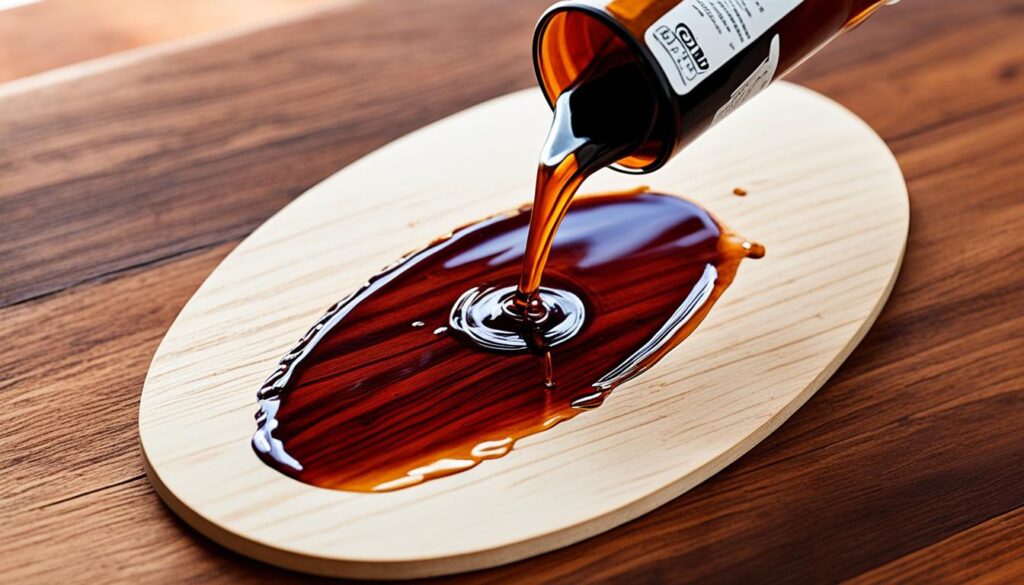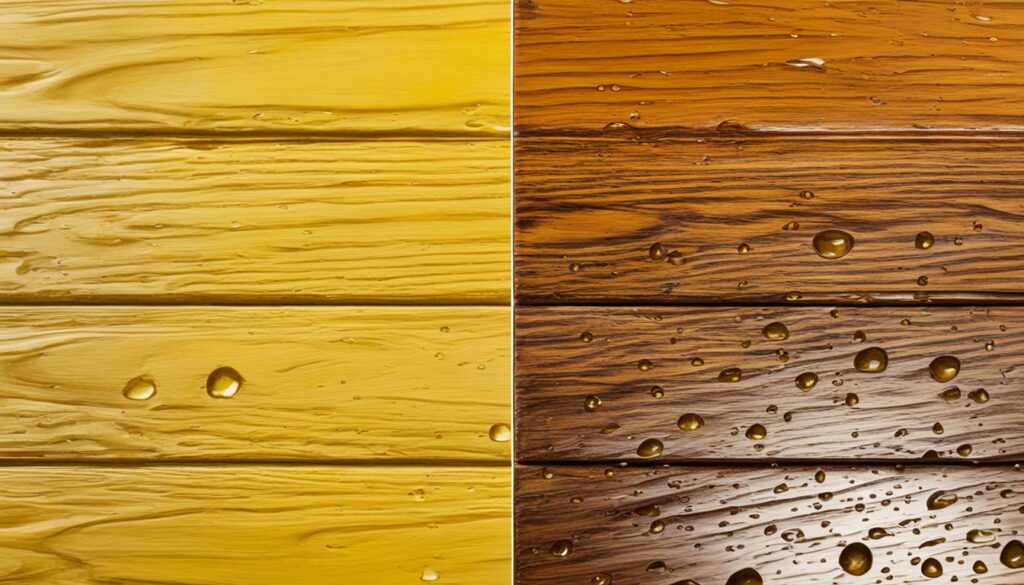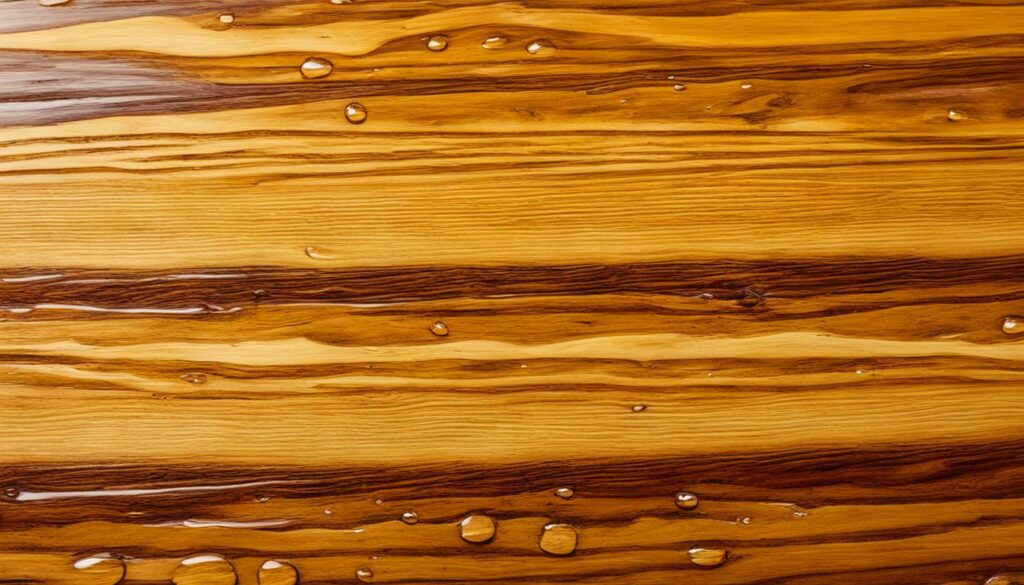I’m a fan of making things from wood. Tung oil is my go-to finish for wooden projects. It comes from the nuts of the tung tree and is top-notch for protecting and keeping wood nice for a long time.1
Tung oil is great because it fights off water, scratches, acids, and even mold.1 It does this without getting damaged itself, if you put it right on top of the wood stain.1 Plus, the Pure Tung Oil I like, from Real Milk Paint Co., isn’t harmful to breathe and smells like nuts.1
Using tung oil over an oil-based wood stain? It’s best to mix the stain with the tung oil first.1 And if you need to remove the stain first, the Soy-Gel Professional Paint Remover can do the trick. It’s from Real Milk Paint Co. too.1
With a water-based stain, tung oil gives even better protection.1 It sinks deep into the wood to defend against water, mold, and more. But remember, Pure Tung Oil needs to be mixed with something like Odorless Mineral Spirits first.1
Tung oil is cool because it turns hard by reacting with the air.1 Full hardening can take up to 30 days. And before then, wait at least 5 days to see it get started.1
Benefits of Applying Tung Oil to Stained Wood
Using tung oil on stained wood surfaces has many advantages. It guards wood against water, scratches, acids, mold, and mildew.1 Made by Real Milk Paint Co., Pure Tung Oil is 100% pure and has no VOCs. This makes it safe to use in small spaces.1
Tung oil is a type of natural drying oil. It comes from the tung tree’s nuts and has been used since ancient times in China.2 Unlike some finishes, pure tung oil doesn’t change color. It gives wood a lovely golden hue.2 You can use tung oil on furniture, decks, floors, and more.2
The oil creates a matte, non-greasy finish. This enhances the wood’s natural look and feel.2 Tung oil is great because it doesn’t need another sealer. It keeps water out on its own.2 Plus, it makes the wood harder and better at resisting water than linseed oil does.2
Adding tung oil on water-based stains makes wood last longer. It helps fight off water, mold, acids, and scratches better.1 But, don’t use tung oil on top of oil-based finishes. The oil-based finish blocks the wood, so the tung oil can’t get in.1
To apply, mix Pure Tung Oil with solvents like Odorless Mineral Spirits or Orange Oil. Do it with a 1:1 ratio before using.1 The oil soaks in quickly, but it takes 15 to 30 days to fully dry.1 For best results, let the wood sit for at least 5 to 7 days for a light coat, and 15 to 30 days for a deep coat.1
Can You Use Tung Oil Over Oil-Based Wood Stain?
Applying tung oil over oil-based wood stain needs careful thought. A forum discussion suggests avoiding 100% pure tung oil for stained wood. This is because it can’t go through the varnish in the stain.3 Also, be aware that not all finishes labeled 100% tung oil really contain tung oil. They may just look and feel like it.3
Garnet shellac might be a better choice than tung oil for things like a wine rack. It’s more able to resist water.3 For the best results on projects like a wine cabinet, add mineral spirits to your varnish. This mixing varnish can improve the finish.3
If you do use tung oil over stain, know you’ll likely need several coats. This can help protect the wood better. However, water could still be a problem with tung oil finishes.3 It’s key to tell the difference between real tung oil and products that look like it. There’s often confusion and incorrect labels in the market.3 For a more durable finish, adding extra coats of wiping varnish is a good idea.3
| Consideration | Recommendation |
|---|---|
| Using 100% pure tung oil over oil-based stain | Not recommended due to inability to penetrate varnish binder3 |
| Tung oil finishes labeled as 100% tung oil | May not actually contain tung oil, but resemble its color and viscosity3 |
| Alternative finish for a wine rack | Garnet shellac, as it is more water-resistant than tung oil3 |
| Optimal finishing for a wine cabinet | Creating a mixing varnish with mineral spirits3 |
| Applying tung oil over oil-based stain | Requires multiple coats for better protection, potential for water damage3 |
| Differentiating genuine tung oil from products labeled as such | Potential misconceptions and mislabeling within the market3 |
| Enhancing finish durability | Applying additional coats of wiping varnish3 |

Applying Tung Oil Over Water-Based Stain
Adding tung oil on top of a water-based stain works great. It gives more protection to your project. Unlike oil-based stains, water-based types let the tung oil soak in better.
When you apply tung oil over water-based stains, it shields well. It protects against water, mold, and more.1 Tung oil hardens as it dries, making a tough sheen. This makes it last longer than linseed oil that can wear off.1
Use Pure Tung Oil from Real Milk Paint Co. with solvents in a 1:1 mix. Do this before oiling your wood.1 The oil will soak in about 15 minutes. But, it needs up to 30 days to fully harden.1 So, let it dry right for the best finish. Expect it to partly harden in 5 to 7 days. Complete dryness comes after 15 to 30 days.1
Choosing the Right Tung Oil Product
Choosing the tung oil you use for wood is key for best results. Not all products are the same. Some don’t even have pure tung oil.3
For top protection and lasting strength, pick 100% pure tung oil products. The ones from Real Milk Paint Co. fit the bill. These items use pure china wood oil. Plus, they’re free of volatile organic compounds (VOCs).1
Then, there’s Formby’s Tung Oil Finish. It’s not really tung oil, but a varnish from soya oil and alkyd resins.3 They might say they’re tung oil, but they don’t protect and soak in like pure tung oil.1
When you’re picking a tung oil finish, check the product info very well. Look for “100% pure tung oil” or “natural tung oil”. This guarantees you’re getting a top-notch, real product.1 Consider brands like Old Masters 100% Tung Oil and Minwax Tung Oil Finish. They’re good choices too.4
Source Links
- https://www.realmilkpaint.com/blog/tips/how-to-apply-tung-oil-to-stained-wood/
- https://www.dutchcrafters.com/blog/things-to-know-about-tung-oil/
- https://sawmillcreek.org/showthread.php?133481-Tung-Oil-over-Oil-based-stain
- https://www.thisoldhouse.com/woodworking/21015659/how-to-pick-tung-oil-finishes
Welcome to WoodCraftYard.com, your one-stop destination for all things woodworking! I’m Oliver Candler, a dedicated woodworking aficionado and the creative mind behind this virtual woodworking haven. With a deep-rooted love for craftsmanship and a keen eye for detail, I am on a mission to share my passion for woodworking with fellow enthusiasts like yourself.
As a seasoned woodworker, I am committed to providing you with valuable insights, practical tips, and inspiring project ideas to help you unleash your creativity and master the art of woodworking. Whether you’re a seasoned pro or just starting out on your woodworking journey, join me as we carve, sand, and saw our way through the world of woodworking together.
Let’s embark on this woodworking adventure, where every knot, grain, and finish tells a unique story. Together, let’s craft, create, and build something truly extraordinary at WoodCraftYard.com!



